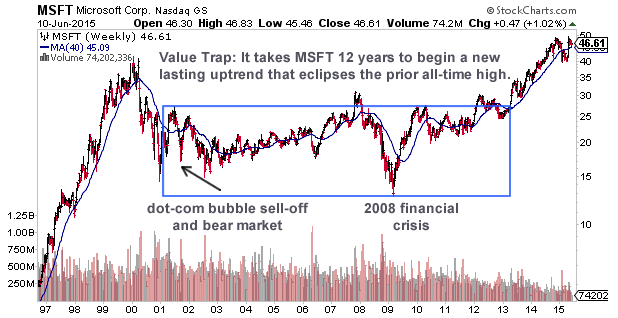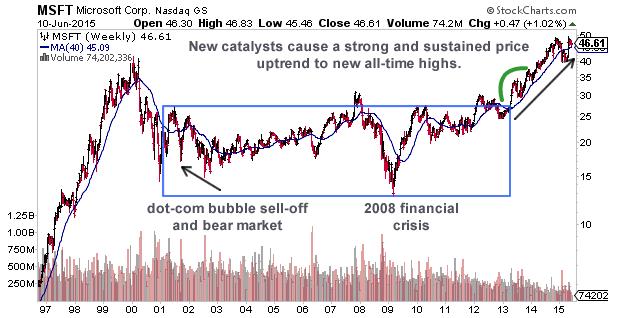How To Spot An Out Of Favor Company Ready To Explode

While most people view contrarian investing and momentum investing as mutually exclusive and polarizing strategies, the reality is different. Marrying the two is a powerful combination.
Contrarian investors believe they can beat the market by betting against prevailing market opinion. Generally, they buy stocks that have been beaten down, stocks that the vast majority of investors refuse to touch.
The goal is the same as with almost all investing strategies: Buy low while the stock is hated and sell high once it’s returned to popularity.
Some of history’s most successful investors have been contrarians. Baron von Rothschild, Warren Buffett and George Soros all made their fortunes in part by betting against prevailing market opinion.
Baron von Rothschild, for example, was a London-based financier in the 18th century. He is often considered to be the father of contrarian investing. You probably know him from his most famous piece of investing advice: “Buy when there’s blood in the streets.”
Buffett has indelibly stated his modern version: “Be fearful when others are greedy, and greedy when others are fearful.”
Indeed, Buffett stepped up to the plate during an extremely frightening moment for investors — the 2008 financial collapse. He invested $ 5 billion in Goldman Sachs (NYSE: GS) to bolster investor confidence and keep the lights on at the investment bank.
The Federal Reserve had his back, and Buffett made out like a bandit. It took only six months for the stock to recover, and Buffett’s savvy contrarian investment generated 64% returns by April 2013.
However, this begs the question: What about the stocks that don’t come back?
Herein lies the Achilles’ heel of contrarian investing — the value trap.
Stocks stuck in a value trap look ever more attractive the lower their price falls, but if no one else is buying them, their price will never go up.
Your money ends up trapped in an investment that looks attractive but may go nowhere for years. Microsoft (NASDAQ: MSFT) is a prime example:

You can see why contrarian strategies seem incompatible with momentum investing, which focuses on buying stocks that are outperforming the rest of the market. The two ideas couldn’t be any more in opposition if they tried.
But contrarian investors don’t like getting stuck in value traps either. Some contrarian investors, like hedge fund legend Seth Klarman, have solved this problem by looking for out-of-favor stocks backed by an investment catalyst.
A catalyst is an agent that provokes or speeds a significant change or action. Some stock-related catalysts include:
— A positive change that causes a sustained increase in earnings power
— A positive change in management personnel and/or company strategy
— The prospect of a merger or acquisition
— A positive change in industry outlook
For a stock that almost no one wants, one of these events can cause a collective rethink on the expectations for the company, giving investors a reason to buy — sometimes aggressively. This usually marks the beginning of a turnaround in the undervalued stock.
Effectively, catalysts represent a change in trend for the company. This is ideal for contrarian investors who are looking to capture the gains from these new trends while also avoiding the dreaded value trap.
It’s also ideal for momentum investors. You see, while the out-of-favor company is underperforming, it tends to create long-term sideways price action. When the stock finally starts to climb out of the doldrums, the sudden surge in price momentum shows up in the form of strong relative strength.
Welcome to the intersection of contrarian and momentum investing.
By adding recently out-of-favor stocks that are just starting to gain momentum from a positive catalyst, we can catch them on their way to the top. Those long-term price consolidations create strong technical launch pads for new price uptrends.
Let’s revisit my prior example of Microsoft. Following the dot-com bubble and subsequent bear market, shares struggled to regain their prior momentum. During that time, the company dealt with a high-profile legal battle with the government over whether it was operating as a monopoly, unveiled its Windows Vista operating system to heavy criticism, made an unsuccessful attempt to acquire Yahoo (NASDAQ: YHOO) and saw its beloved CEO and founder Bill Gates officially transition out of his day-to-day role.
MSFT was widely disliked, the very picture of a contrarian stock. Then, in 2013, a number of bullish events occurred:
— CEO Steve Ballmer retired
— Windows 8 was released
— Microsoft successfully acquired Nokia’s phone business
— The president of ValueAct Capital Management was added to Microsoft’s board of directors
— Management increased its quarterly dividend payment and announced a new $ 40 billion share buyback program
These events touch all the catalysts I mentioned above and caused a 36% momentum surge (green curve on the chart below) during the first half of that year — an ideal “buy” candidate for a momentum investor.

This plethora of new catalysts caused investors to rethink their position on Microsoft, leading to a new uptrend that’s lasted through today.
So now you understand how contrarian and momentum investing can work together to create powerful synergies able to identify stocks capable of big trends. And we can avoid waiting years to capture them.
So, in addition to the normal momentum screen I run to find investments on the verge of a breakout, I ran a second algorithm screening for stocks that were out of favor and significant underperformers over the past three years but now show surging relative strength.
It uncovered three prime buy candidates — a wireless communications company that staged a huge turnaround in its latest quarter, a semiconductor stock that smashed through long-term resistance, and a tanker company that now ranks in the top 1% of all stocks in my database based on a powerful momentum indicator.
If you’re interested in getting the names of these stocks or learning more about how I spot stocks on the verge of a breakout, follow this link.


